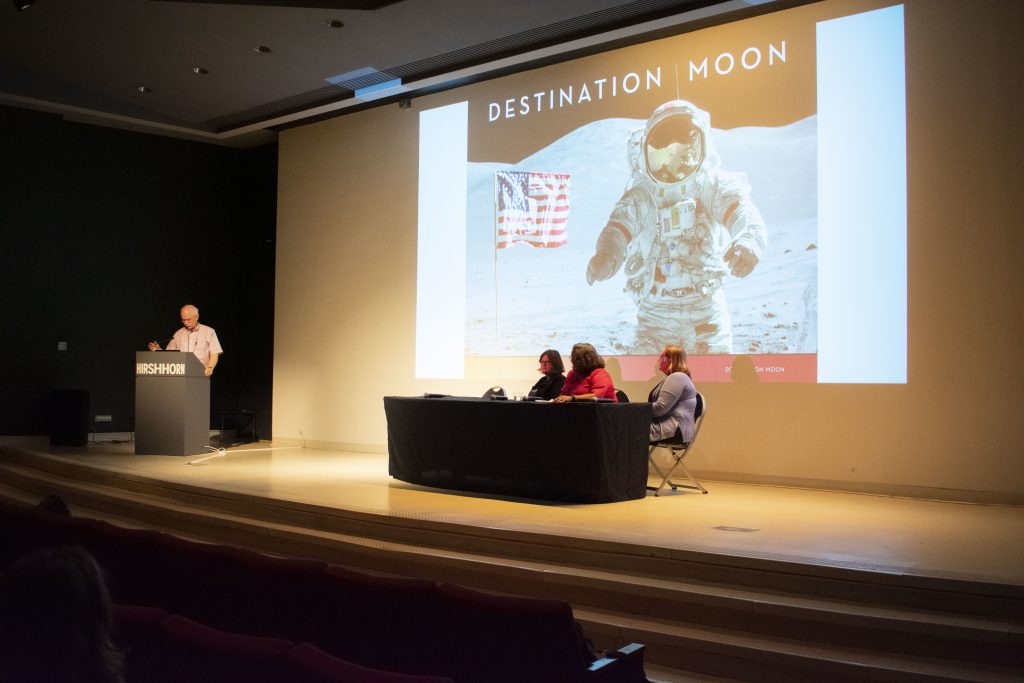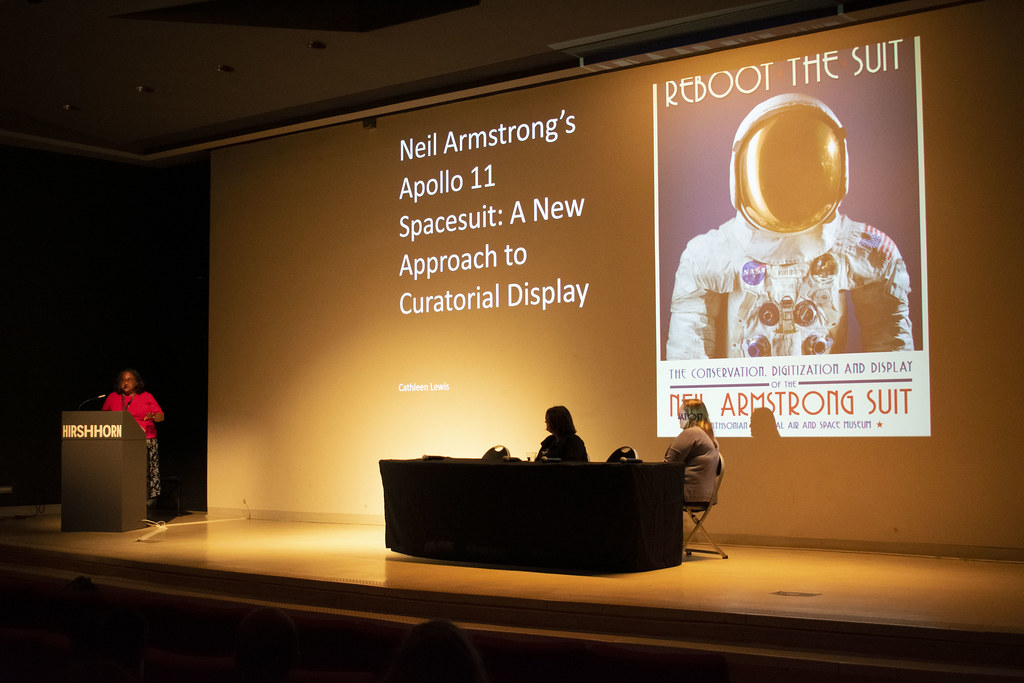On Thursday October 9th 2019, 50+ people attended the meeting at the Hirshhorn Museum and Sculpture Gallery for a panel on: Destination Moon: Multi-departmental Collaboration in Exhibits.
There were four speakers from the National Air and Space Museum (NASM), who all gave very different perspectives on the re-development of the museum on the National Mall, which will happen over the next few years.

There were two curators, an exhibition project manager, and a conservator.
Michael Neufeld is a senior curator in the Space History Department, responsible for the rocket collection and Mercury and Gemini spacecraft. He gave an overview of the concept and narrative of the new gallery. He spoke about the impetus for the redevelopment project and the desire to adequately commemorate the 50th anniversary of the first moon landing. However, he also explained how the project evolved to something far more ambitious, for example including a commemorative coin (fundraising for the new galleries) and a Kickstarter for the Armstrong spacesuit (to fund scientific investigation and conservation work).
The new gallery “Destination Moon” will span from ancient Greece to the contemporary space program but will focus on the Apollo-era with key (big!) objects including the Command Module Columbia, the Armstrong suit, and a Saturn V F-1 engine hanging from the roof. Large murals will span the walls, including a 1940s image of the surface of the moon looking back to the Earth by
Bonestell.
The gallery was still under development during the major moon landing anniversary, so Neufeld spoke about how they ensured key objects could still be on view during this important celebration – by taking them on the road. The exhibition is currently at its final venue in Cincinnati (https://www.cincymuseum.org/destination-moon/), and then Columbia will return to NASM and be
displayed to the public at the Udvar-Hazy Center after March 3.
Next up was Ashlee Prevette, Exhibit Project Manager. She is responsible for the scope, schedule, and budget for temporary and permanent displays, including eight new galleries – approximately half of the Museum’s redevelopment effort.
She spoke about the challenges of this major project which has been broken into three stages – with three different contracting arrangements – and how to tie them together into a single museum. She also mentioned issues of dynamically changing plans, unexpected structural issues, and integration of different funding streams to ensure the best outcome for the display and protection of the collection. For example, she is making sure funding for the exhibition fit-out matches federal funding for the building structure so that the enormously heavy F-1 engine can be suspending from the ceiling!

Cathleen Lewis, Curator of International Space Programs and Spacesuits, spoke about how her early focus on Soviet and Russian history and her responsibility for a handful of Soviet suits suddenly extended to over a thousand suits and components when another colleague retired. She presented on the history of display of the Apollo 11 suits, starting with their first display in the Arts and Industries Building in 1972 soon after they had finished a post-mission national tour. The moon landing was only 5 years previous, so it was still in everyone’s personal memory. But as time went on, the challenge was to manage the deteriorating condition of the suits, originally thought to be stable due to their use in space, and the generational change in their audience. She highlighted the difficulty of attracting funding even if there is a clear project goal identified by both curators and conservators and the need for the Kickstarter to “Reboot the Suit.” This campaign created new challenges such as bringing an additional 9,477 stakeholders into the preservation work, but it also provided opportunities to take advantage of new technology to fully document the suit including X-radiography, CT scanning, and 3-D digitization. It also had unexpected bonuses, such as being contacted by a former employee who had worked on the manufacture of Armstrong’s suit and had held on to a trove of archival and engineering documents he saved from shredding many years before.
Conservator team leader Lisa Young spoke from her perspective about the essential qualities and challenges for conservators working in the large multi-disciplinary project teams. The entire museum re-development is to be completed in only a few short years, so conservators need to be able to confidently weigh in on factors for display. For example, when presented with the idea of just scooting in a 1000 lb Command Module below a mezzanine, how could they realize the designers’ vision? At NASM, the collection is so varied, and conservators work on “spacecraft, aircraft, and everything in between.” Challenges range from a wide variety of hazardous materials to physically accessing large, awkward objects for treatment. For example, one project required fabrication of a custom rolling scaffold which curved up and over a huge unfurled antenna. Lisa also spoke about varying approaches to the collection, ranging from restoration to “less is more.” Sometimes important evidence of use must be preserved, for example tears from training or embedded moon dust on spacesuits.
At the end, audience members asked follow-up questions:
How do they ensure there is consistency with three different contracts?
Exhibition guidelines were drafted by Conservation and Exhibitions departments as a starting point, for example specifying what materials can and cannot be used; this will be refined for each
subsequent contract.
What are the key features of the new Armstrong case?
Active conditioning of the case with temperature and relative humidity control and pollutant scrubbers for off-gassing. From their research, controlling relative humidity (more than temperature
control) seemed the key to limiting plasticizer migration.
How do they check what the public thinks of their renovation?
“Our exhibitions staff like to use Yelp.”
October WCG meeting summarized by Karen Wilcox